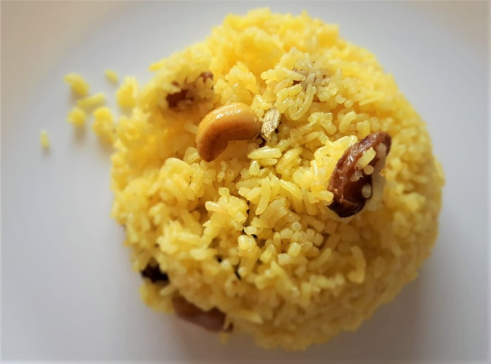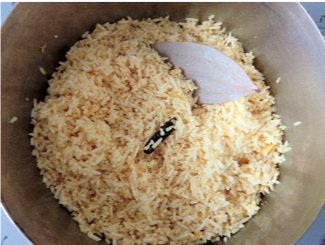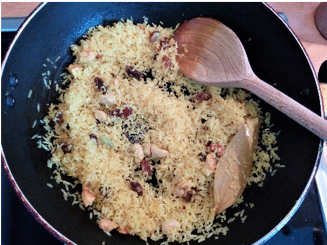Khai khai koro keno, esho bosho ahare,
Khaobo ajob khaoa, bhoj koi jahare.
~ Sukumar Roy

As a Bengali, even if one has not tasted Basanti Pulao, one must have heard the name. Also known as halud misti pulao, it is a bright yellow, sweet rice dish cooked with ghee and garnished with fried cashews and raisins.
To understand the origin of this mouth-watering dish and how it became a part of Bengali kitchen, let us first explore the history of pulao. Pilaf or Pilau is a rice dish whose recipe usually involves cooking in stock, adding spices and other ingredients such as vegetables or meat. In one version, the origin of this rice cooking style can be traced back to 9th century. It is believed to have spread from Spain to Afghanistan and eventually to the rest of the world. That is the reason Spanish paella, pulao and biriyani bear some degree of similarity. The earliest documented recipe comes from books written on medical science by the 10th century Persian scholar Avicenna.
Another version points out that though the terms pallao, pulao and pilav were invented by the Persians and Arabs, it was already referred to as pallo or pulao in Sanskrit and Tamil much before the Muslim rulers invaded India. There is even reference of Yaggaseni cooking pulao in Mahabharata. Maharshi Charaka had mentioned in Ayurveda that rice cooked with meat, spinach, oil, ghee and miscellaneous fruits is tasty, heartening, restorative and nutritious.
Let’s come back to our Bengali version of the pulao. As per food researchers, Basanti pulao is believed to have originated from the Shahjahani Zard pulao. An interesting fact to note is that the royal kitchen of Shah Jahan used sugar heavily in pulao and even in meat dishes! Eventually, the Bengali zamindars got influenced by the Nawabs of Murshidabad and started using saffron in their food. It soon became a famous celebratory dish among commoners too and saffron being expensive, was substituted by turmeric.
This pulao is cooked with a special kind of aromatic rice called Gobindobhog. As it is quite difficult to find this rice variety outside West Bengal (India), I have always used Basmati rice and it tastes equally good. There are various forms of recipe for this dish, but I have written the one taught to me by my mother, who in turn was taught by her mother. Let’s have a look.
Serving: 4 persons
Preparation time: 80 minutes
Cook time: 20 minutes
Ingredients:
- 350g Basmati rice
- 75g ghee
- 1 cinnamon stick
- 4 pcs cardamom
- 5 pcs cloves
- 2 bay leaves
- 5gm ginger paste
- 1/2 tsp turmeric
- 1.5 tsp sugar
- ¼ cup cashew nuts
- ¼ cup raisins
- 3 green chillies
- 0.7 litre water
- Salt to taste


Method:
- Wash and rinse the rice and spread it on a paper to air dry.
- When dry, transfer the rice to a bowl and mix with 65gm ghee, ginger paste, turmeric, cardamom, cinnamon, cloves, bay leaves. Rub the spices and ghee over the rice granules so that the whole rice is covered well. Let it marinate for one hour.
- Take a cooking pot and heat 10gm of ghee. Fry the cashew nuts until golden brown.
- Add the marinated rice to it and fry on medium heat until the rice becomes opaque.
- Add the raisins and further fry for 2 minutes.
- Boil water and add to the pot.
- Add salt and sugar and give it a light stir.
- Cover cook on low heat for about 15 minutes.
- If the rice looks too dry, add some more hot water and further cook for 5 minutes.
- Once the rice has been cooked to the perfect texture, cover and let it sit for 5 minutes before fluffing it.
- Serve warm with any vegetarian or non-vegetarian dish of your choice.
Ato kheye tobu jodi nahi othe monta —
Khao tobe kochu pora, khao tobe ghonta.